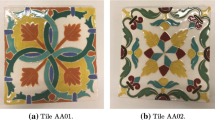Abstract
The glass beads unearthed in sites along the Silk Road usually indicate the communications of arts, business, and cultures between different areas. The production process of glass beads also implies an associated local culture, as well as its provenance. Computed tomography (CT) is a non-destructive three-dimensional method and it has been widely used in the research of various relics. It contributes to discovering and documenting the manufacturing processes for artifacts. Based on the CT images of two glass beads which were unearthed in Khotan, **njiang, China, the inner structure and air bubble shapes were investigated. This paper demonstrates how the CT technology contributes to studying the manufacture of archaeological glass beads. Two polychrome beads were analyzed by CT scanning techniques. Bead S-2 is a typical natron glass and bead SC-8 is a soda-lime-silica glass, based on the chemical components analyzed by laser ablation inductively coupled plasma atomic emission spectrometry (LA-ICP-AES). According to computed tomographic analysis, a porous core was covered with a thick layer of glaze. The eye parts from S-2 eye bead were probably made by an embedding technique, which was proved by the 3D shapes of bubbles and the “eyes.” The SC-8 bead was manufactured by a stretching technique which was evidenced by the elliptical bubbles. The yellow stripes wrapped around the glass base present sharp edges in cross section, which seem to reflect grooves carved before the filling process.









Similar content being viewed by others
References
Baruchel J, Buffiere JY, Cloetens P, di Michiel M, Ferrie E, Ludwig W, Maire E, Salvo L (2006) Advances in synchrotron radiation micro-tomography. J Scr Mater 55(1):41–46. https://doi.org/10.1016/j.scriptamat.2006.02.012
Betz O et al (2007) Imaging applications of synchrotron X-ray phase-contrast micro-tomography in biological morphology and biomaterials science. I. General aspects of the technique and its advantages in the analysis of millimetre-sized arthropod structure. J Microsc 227(1):51–71. https://doi.org/10.1111/j.1365-2818.2007.01785.x
Ferdinand von Richthofen (1877) China: Ergebnisse Eigener Reisen Un Darauf Gegründeter Studien, Berlin, pp 454
Henderson J (1991) Chemical characterization of Roman glass vessels, enamels and tesserae. In: Materials issues in art and archaeology II, pp 601–607
Jensen TH, Bech M, Bunk O, Thomsen M, Menzel A, Bouchet A, le Duc G, Feidenhans'l R, Pfeiffer F (2011) Brain tumor imaging using small-angle X-ray scattering tomography. J Phys Med Biol 56(6):1717–1726. https://doi.org/10.1088/0031-9155/56/6/012
Laure D, Bernard G (2013) Glass in South Asia, in: Koen H. A. Janssens (Eds.), Modern methods for analysing archaeological and historical glass. Wiley-Blackwell Publishing House, U.K., 399–411
Meicun L (2006) Fifteen lectures on archaeology of the silk roads. Peking University Press, Bei**g, 1–4
Qian C 2017. The analytic report of “The origin and technology of glasses excavated in Shanpula cemetery, Khotan, **njiang Uyghur Autonomous Region.”, Bei**g, Unpublished Report
Rehren T (2008) A review of factors affecting the composition of early Egyptian glasses and faience: alkali and alkali earth oxides. J Archaeol Sci 35(5):1345–1354. https://doi.org/10.1016/j.jas.2007.09.005
Rongchang C et al (2012) PITRE: software for phase-sensitive X-ray image processing and tomography reconstruction. J Synchrotron Radiat 19(5):836–845
Shijie C et al (2013) Studying frozen soil with CT technology: present studies and prospects. J Glaciol Geocryol 35:193–200
Tafforeau P, Boistel R, Boller E, Bravin A, Brunet M, Chaimanee Y, Cloetens P, Feist M, Hoszowska J, Jaeger JJ, Kay RF, Lazzari V, Marivaux L, Nel A, Nemoz C, Thibault X, Vignaud P, Zabler S (2006) Applications of X-ray synchrotron micro-tomography for non-destructive 3D studies of paleontological specimens. Appl Phys A Mater Sci Process 83(2):195–202. https://doi.org/10.1007/s00339-006-3507-2
Tite M, Bimson M (1986) Faience: an investigation of the microstructures associated with the different methods of glazing. Archaeometry 28(1):69–78. https://doi.org/10.1111/j.1475-4754.1986.tb00375.x
Vicenzi et al (2002) Microbeam characterization of corning archaeological reference glasses: new additions to the Smithsonian microbeam standard collection. J Res Natl Inst Stand Technol 107(6):719–727. https://doi.org/10.6028/jres.107.058
**njiang Museum, The Institute of Cultural Relic and Archaeology of **njiang (2001) Shanpula of **njiang China—the open out and research of ancient Yutian civilization. **njiang People’s Publishing House, **njiang
Yang Y, Wang L, Wei S, Song G, Kenoyer JM, **ao T, Zhu J, Wang C (2013) Nondestructive analysis of dragonfly eye beads from the warring states period, excavated from a Chu tomb at the Shenmingpu site, Henan Province, China. J Microsc Microanal 19(02):335–343. https://doi.org/10.1017/S1431927612014201
Yuqi R et al (2013) X-ray imaging and its biomedical applications at SSRF. J. Chin. Bull Life Sci 25:762–770
Acknowledgements
The authors would like to acknowledge the laboratory assistance of BL13W (SSRF, Shanghai, China) and would like to thank the National Nature Science Foundation of China (No. 31100680), the Joint Funds of the National Natural Science Foundation of China (No. U1232205), and the National Social Science Foundation of China (11CKG010) for the financial support. The authors would like to thank the Museum of **njiang Uygur Autonomous Region for providing the samples and the background information.
Author information
Authors and Affiliations
Corresponding authors
Rights and permissions
About this article
Cite this article
Cheng, Q., Zhang, X., Guo, J. et al. Application of computed tomography in the analysis of glass beads unearthed in Shanpula cemetery (Khotan), **njiang Uyghur Autonomous Region. Archaeol Anthropol Sci 11, 937–945 (2019). https://doi.org/10.1007/s12520-017-0582-6
Received:
Accepted:
Published:
Issue Date:
DOI: https://doi.org/10.1007/s12520-017-0582-6




